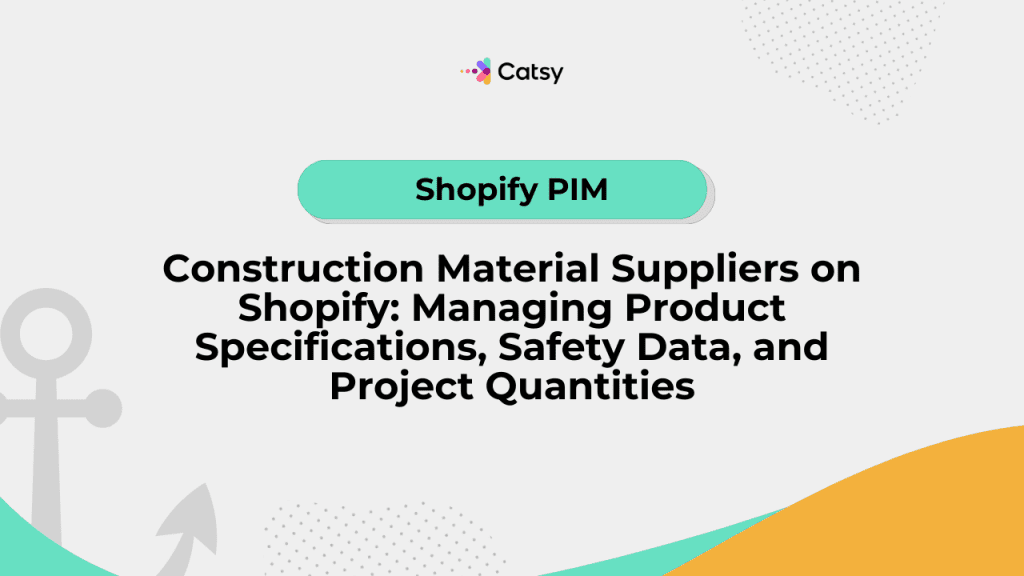Construction Material Suppliers on Shopify: Managing Product Specifications, Safety Data, and Project Quantities

Chart Your Construction Course
What You’ll Learn:
- Strategic approaches to construction material specification management on Shopify
- Safety data and building code compliance frameworks for material suppliers
- Project quantity management systems that serve contractors and large-scale buyers
- Implementation strategies that bridge consumer e-commerce platforms with professional construction requirements
In this Article
Construction Materials E-commerce: Charting Structural Waters
Construction material suppliers who operate on Shopify face unique challenges. Construction professionals require details, details, details! From material properties to building code compliance information, and from safety certifications and project quantity capabilities, your data reflects construction realities – and your consumers need that data.
What Makes Construction Materials Unique?
Construction materials involve precise structural specifications, load ratings, compliance data, and more. And these requirements may vary from location to location.
Each material requires extensive documentation including performance data, installation guidelines, safety information, and compatibility requirements that contractors rely on for project planning and code compliance.
Individual products are just the start! Project-based purchasing patterns, bulk pricing, delivery coordination, and integration with management workflows must also be considered.
Traditional retail e-commerce approaches often fail to navigate these professional requirements, forcing suppliers to choose between simplified presentations that frustrate contractors or complex systems that overwhelm the occasional hobbyist.
Why Professional-Grade Data Management Has Become Essential for Charting Construction Success
The construction industry has evolved toward more efficient project management. Similarly, procurement processes that demand immediate access to comprehensive data are becoming more mainstream. Your customers need accurate availability data and streamlined ordering systems that accommodate short project timelines and varied budgets.
When you make the move to sophisticated material specification management, you’re allowing your contractors to make informed decisions. You’re also reducing project delays that can be caused by confusion about specifications or compatibility.
Integrating your material data with project management systems and construction workflows is critical to your competitive standing. Suppliers that provide immediate access to accurate information have huge advantages over those who rely on catalogs and spreadsheets.
Make Catsy DAM and PIM Software an Extension of Your Team
Book a Free DemoProduct Specification Management: Setting Your Structural Coordinates
Structural and Performance Data:
Load ratings, compression strength, tensile strength, and environmental resistance characteristics all require systematic organization. Your customers will want this data to be presented in a format that can be quickly evaluated while still ensuring accuracy.
Building Code and Standards Compliance:
Construction materials must be in compliance with building codes. Industry standards and regional regulations also impact your buyer’s decision. Specification management should integrate compliance info while allowing contractors to understand what is required for their specific projects and locations.
Application and Installation Guidance:
Many construction materials require specific installation procedures, environmental conditions, or compatible components. Product management systems can coordinate this while keeping information accessible to field personnel – these users may need quick reference during installation.
Material Compatibility and System Integration:
Construction materials involve multiple materials, and each of those materials must work together. This requires attention to compatibility, expansion, chemical interactions, and more. Specification management should address these relationships to help contractors shop holistic systems rather than single components.
Safety Data and Compliance Framework: Navigating Regulatory Waters
Material Safety Documentation:
Construction materials often involve health and safety considerations. This could include skin contact precautions, respiratory protection, or environmental impact as a whole. Managing this information requires integration with customer-facing displays to allow safety-critical information to be immediately accessible.
Building Code Integration:
Construction materials must meet building code requirements. These requirements may vary by project, location, or application. Compliance management means tracking which codes apply to which materials while also providing clear guidance about usage limitations or restrictions.
Environmental and Sustainability Compliance:
More and more, construction professionals must meet environmental standards and green building requirements. Specification systems should include this information so your contractors can understand a material’s contribution to sustainability goals.
Hazardous Material Handling:
Some construction materials involve hazardous substance regulations or disposal considerations. Safe handling practices may also be important. Safety management ensures that all necessary precautions are communicated throughout the entire procurement and handling cycles.
Project Quantity Management: Charting Bulk Purchasing Waters
Project-Based Ordering Systems:
Your customers will likely purchase materials in quantities that reflect their unique projects; hobbyists buy small while contractors may make larger purchases. Your ordering systems must accommodate quantity calculations, material waste factors, and delivery that makes sense for your customer and your business.
Bulk Pricing and Volume Discounts:
Volume discounts attract large purchases, and project-based pricing is common, too. Pricing systems should handle complex tier structures while still providing clear, transparent pricing information. This allows contractors to accurately bid on projects.
Delivery Coordination and Logistics:
Do your construction materials require specialized delivery equipment? What about site access coordination? Management systems should integrate delivery logistics right within the proffering process. Provide realistic delivery scheduling but account for site constraints and any equipment requirements.
Inventory Planning and Availability:
Your customers are operating on a deadline, and they want you to deliver on your shipping promises. Their success is at stake, so provide reliable availability data while enabling advance ordering. Consider implementing delivery scheduling to support your customers’ planning requirements.
Catsy PIM: Your Construction Material Content Navigator
Comprehensive Specification Data Management:
Catsy PIM excels at managing construction materials’ complex tech specs. We provide structured approaches to building code compliance and application data while enabling robust search and comparison capabilities. Your customers will thank you.
Safety and Compliance Integration:
Catsy’s content management capabilities integrate your safety documentation, building code compliance information, and regulatory compliance requirements with your product specs.
This integration ensures that safety-critical information and compliance data remain current and accessible while reducing administrative overhead for suppliers managing complex regulatory requirements.
Advanced Asset Management for Technical Documentation:
Construction materials require extensive documentation. That may include installation guides, technical drawings, compliance certificates… the list goes on!
Catsy’s DAM capabilities provide organization and delivery of these assets. Meanwhile, you have full version control and the assurance of consistency across your channels.
Project-Focused Content Syndication:
Catsy enables consistent presentation of all your construction material information across the channels you opt in to. E-commerce platforms, contractor portals, management systems, and specs databases are seamlessly synced.
This capability is particularly valuable for construction suppliers who serve customers through multiple channels, especially in global markets.
Top 5 Strategies for Charting Construction Material E-commerce Success
- Design for Project-Based Decision Making: Construction pros choose materials that are suited to the project requirements, building codes and other attributes – they’re not just browsing categories. Your content should reflect this. Organize your product information to support project planning processes. You can do this by providing comprehensive specs and compatibility information that will help your contractors choose the applicable materials.
- Implement Comprehensive Compliance Integration: Building code compliance and safety requirements aren’t separate from your other product information. This information should be integrated into the customer experience. Ensure that your compliance information, safety documentation, and regulatory guidelines are accessible to your consumer. Don’t forget to include appropriate legal disclaimers throughout the customer-facing purchase process.
- Create Flexible Quantity and Pricing Systems: Construction purchasing often involves varying quantity requirements. One customer may be a hobbyist with a small repair job while the other may be a national contractor with multiple projects. Develop quantity pricing approaches to handle project calculators, bulk pricing, and even delivery coordination options. Make this information clear and transparent to each customer.
- Establish Robust Technical Content Governance: Construction material information must reflect accuracy and completeness – this directly impacts the safety of your customer. Implement content governance processes to ensure that your safety information is up to regulatory standards.
- Plan for Logistics and Delivery Integration: For construction jobs, materials are frequently delivered with specialized equipment and site access restrictions. Chart your systems to handle logistics efficiently. Provide realistic delivery expectations and cost transparency that supports project planning.
Real-World Construction Materials Implementation Success Stories
Commercial Building Supplier Transformation
A commercial building material supplier needed to serve both general contractors and smaller ones. Large-scale contractors required detailed specifications, but the smaller contractors only needed basic material information.
The company’s implementation of a PIM created segmented experiences that provided the appropriate technical depth to each consumer type. Comprehensive compliance information and project quantity capabilities allowed easy ordering for both segments.
Structural Steel and Metal Fabrication Specialist
A structural steel supplier struggled to manage comprehensive load rating information and building code compliance data while providing custom fabrication capabilities. Their catalog included thousands of standard and custom SKUs.
Their solution? A PIM that provided sophisticated specification search alongside comprehensive technical documentation. Furthermore, custom fabrication request capabilities are integrated with their legacy workflows.
Concrete and Masonry Material Distributor
A supplier of concrete and masonry needed to relay complex information to their customers, including mix specifications, curing guidelines, and environmental conditions information. They served both professional contractors and DIY customers.
Their implementation enables technical customers to access detailed engineering data while providing simplified guidance for less experienced users working on smaller projects.
Each of these implementations demonstrate that successful construction material e-commerce requires sophisticated content management. It must address both technical complexity and diverse customer requirements while maintaining accuracy and regulatory compliance.
Working with Construction E-commerce Navigators
Implementing effective construction material e-commerce requires expertise. Knowledge of the construction industry and an understanding of contractor workflows is essential!
The specialized nature of building code requirements, combined with safety and compliance considerations, often exceeds internal capabilities for companies that are focused on material distribution rather than e-commerce technology development.
A professional construction e-commerce specialist understands the unique challenges, from technical materials presentation to compliance data management. They bring experience with proven implementation approaches.
As you evaluate prospective partners, prioritize the candidates with demonstrated experience in construction materials. The right partner will help you implement your PIM, but will also offer strategic guidance as you chart your course.
Key Takeaways
- Construction material e-commerce requires sophisticated specification management to address technical properties, building codes, and professional contractor requirements
- A retailer’s success depends on comprehensive compliance integration combined with project-based quantity management and delivery coordination
- Safety and building code information must be seamlessly embedded throughout the customer experience … don’t treat it as a separate entity
- Catsy PIM provides specialized capabilities for managing complex construction material specifications, safety documentation, and multi-channel content syndication
- Project quantity management and bulk pricing require flexible systems that can handle diverse purchasing patterns as well as delivery logistics
- Professional expertise is often essential for managing the technical complexity and regulatory compliance requirements that construction markets demand
Want more tips, tutorials, and insights on product content and e-commerce operations?
Stay connected. We post regularly to help brands like yours scale smarter.
Are You Ready To streamline your product content management?

Frequently Asked Questions
Establish systematic approaches as early on in the process as you’re able. Your regional building code management should provide clear guidance about relevant code information. Implement geographic detection systems that will present relevant code info. Then, create processes for tracking code updates. Provide clear guidance to your customers as to when professional consultation is recommended for use of your products.
Quantity calculation options will help contractors estimate their materials requirements based on project specs. The estimate will account for waste factors and delivery increments.
Then, create tiered pricing systems that provide transparent volume discounts. Allow your consumer to create project-based order workflows. Finally, be very clear about your delivery constraints.
Implement customer segmentation approaches. These will provide appropriate experiences for different user types – using the same data on the back end.
Consider using progressive disclosure techniques that can present your “basic” information front and center, but that allows for expandable sections to view more complex data. Create separate navigational pathways for your professional and your DIY customers.
Consider your customer base, your technical complexity, and your integration requirements. Shopify customization can address many construction needs, but sometimes custom development may be necessary for advanced features. Comprehensive building code and sophisticated project quantity management are two examples,
Specialized construction platforms or hybrid approaches using advanced PIM systems like Catsy often provide more comprehensive construction functionality while leveraging Shopify’s e-commerce capabilities for customer management and order processing.
Subscribe For More Content
Sign up for monthly tips on how to drive revenue with product content.




